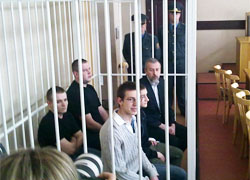Trial against Sannikov: Evidence for defence not attached to case
150- 29.04.2011, 10:13

A trial over Andrei Sannikov proves that there was a provocation organized by the security services on December 19.
On April 29, the Partyzanski district court of Minsk continued hearing in the criminal case against presidential candidate Andrei Sannikov.
Yesterday, 8 out of 29 riot police offices, who were found injured after dispersal of a demonstration on December 19, 2010, were questioned in court. For unknown reasons, most of the “beaten” riot policemen went on holiday for 2010 on April 26. The court recognized these reasons as valid for their absence and was satisfied with reading their evidence given during the preliminary investigation. The evidence seem to have been copied from each other: they were on duty on December 19, arrived on Independence Square, unknown people from a crowd of demonstrators hit them, mainly in knee, then they applied for medical care. None of them wrote about any serious injuries or accused personally Andrei Sannikov and other defendants of violence.
Six lawyers were questioning the injured policemen about details of their service on December 19. Eight riot policemen present at the trial preferred not to speak about their involvement in beating demonstrators. But all of them said that had not seen armature and cans with flame liquid, the items allegedly found by investigators later.
When the defendants asked “injured” policeman Dzmitry Skarakhod why the police had not detained the people who were beating windows in the House of Government, the latter suddenly said, “This was a special tactics. We needed to do this.”
Witnesses for the defence were questioned today. Famous human rights activists Ales Byalyatski and Uladzimir Labkovich, journalist Aleh Hruzdzilovich, participants of the demonstration Pyotr Kuchko, Andrei Staletau, Yulian Sarachuk, Alena Vishneuskaya said the gathering on December 19 was absolutely peaceful. The human rights activists underlined there were a lot of evidence of independent observers confirming that the Belarusian presidential elections were falsified. Tens of thousands of Belarusians took to streets to peacefully protest against the rigged elections and demand holding new free elections without running dictator Lukashenka in them.
There were no calls to violence from the presidential candidates. All presidential candidates, including Andrei Sannikov, demanded to stop provocations, but police did not react and refused to protest public order on the calls of the opposition leaders. Andrei Sannikov again emphasized that the presidential candidates called on the authorities to start negotiations, “I was a deputy minister, so I know that some people work in the House of Government even on weekends, moreover, during the elections. It is always possible to reach a responsible official there. The one, who has the right to report to the government, the prime ministers or deputy prime ministers, who has the right to make decisions.”
Witness Aleh Hruzdzilovich said that demonstrators had not resisted when riot police was pushing them off. Later, when policemen began to beat them with batons, demonstrators had to defend themselves with flagpoles. The witness did not see armature, ice axes, cans, pepper spray, or spades. People were chanting “Police with people”. It was an emotional response to a police attack, a call not to use force, not to beat people. The witness says none of the politician called to use force against police.
People were trying to escape, but riot police moved from the opposite direction and beat everyone. It was a massacre, policemen kicked demonstrators, especially young ones. It was impossible to resist, witness Hruzdzilovich said.
Police was prepared to disperse the demonstration; there were many buses and prisoner transport vehicles in the city centre, the witness said.
Wirness Pyotr Kuchko said he stayed on Independence Square after the dispersal. Riot police did not turn attention to him, an old man. He said there were no bottles, ice axes, cans and other things showed in a film “Iron against the Glass” by BT, a Belarusian TV channel. The witness called the film was a fake and said he had made five photos of the Square after the dispersal on his mobile phone. The pictures show columns of police and a car, but no items showed by BT and mentioned in the materials of the case were seen.
Kuchko asked to attach the photos to the case, but the prosecutor protested. The lawyers supported Kuchko, but the judge refused to attach the photo evidence to the case saying nobody knows when the pictures were made. The defence demands to show the camera to experts to confirm the photos are real.










